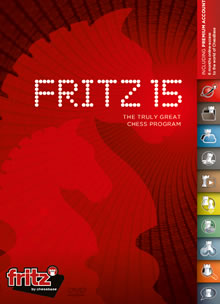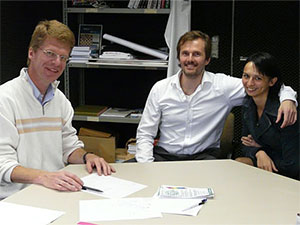The Fritz engine, since the very first iterations, was the brainchild and authored by only one programmer (in spite of rather humorous online rumors of a secret team): Franz Morsch. His engine deservedly became a legend, especially when it single-handedly defeated the super computer Deep Blue (still in prototype) at the World Computer Chess Championships in Hong Kong in 1995. As far as versions were concerned it was Fritz 3 running on a modest Pentium 90MHz.
Over the years Fritz has always been a top engine, providing players with top analysis, but after Fritz 13, the mighty Morsch hung up his hat, and the engine’s code along with him. In keeping with the tradition of a new and stronger engine than its predecessor, as well as new features in the interface, the Fritz 14 engine was signed by Gyula Horváth, and now the baton has been taken up by Vasik Rajlich.
After dominating the ratings lists and world championships for years and years with his engine Rybka, Vasik Rajlich eventually went off to greener pastures as he started a family with Polish IM Iweta Rajlich, and the throne was left vacant. After years of inactivity in the highly competitive computer chess field, he has returned, lending his skills to the next generations of Fritz, starting with Fritz 15.

ChessBase CEO Matthias Wüllenweber in Hamburg with Vas and Iweta Rajlich
The first question for the engine geeks or experienced players is: “Is this simply a rebadged Rybka 4?”
The programmer explains, “Fritz 15 is massively different from Rybka 4.1. The search is very different. I've spent the last six months mostly cleaning up certain aspects of the engine and setting up my infrastructure for testing, tuning, and various automation. It took me a long time (as well as insight from another project) to understand how this should all be structured. This isn't quite done yet but the core is in place. Although, there is very little Elo gain so far from that work. I see it as a foundation for the future.”

Vasik Rajlich - author of Fritz 15
For the record, current testing by specialized computer lists such as CEGT and CCRL, among others, have evaluated Fritz 15 as being somewhere between 30-40 Elo stronger than Rybka 4, however Rajlich comments that he is currently working on Fritz 15.1, which will bring further improvements to its play.
In spite of their incredible ability, the engines have fairly distinct styles of play, much like humans, and whie you may find a brilliant attacking game by Petrosian, to quote an extreme, it is not the usual fare. How does Fritz 15 play relative to Rybka 4?
Vasik replied, “Fritz 15 will have a rather different 'search personality' than Rybka 4, but this won't be anything which is easy to summarize for users.”
Here are a few games from the tests, to illustrate the range of its skills and ability to handle a wide variety of situations.
Wild Tactics and attacking

[Event "CCRL 40/40"] [Site "CCRL"] [Date "2015.12.20"] [Round "14.5"] [White "Fritz 15 64-bit 4CPU"] [Black "BlackMamba 2.0 64-bit 4CPU"] [Result "1-0"] [ECO "A05"] [PlyCount "76"] [EventDate "2015.??.??"] 1. Nf3 Nf6 2. c4 b6 3. Nc3 Bb7 4. d4 e6 5. a3 d5 6. cxd5 Nxd5 7. Bd2 Nf6 8. Bg5 Nbd7 9. e4 h6 10. Bxf6 Qxf6 11. Bb5 c6 12. Bc4 g5 13. O-O O-O-O 14. e5 Qg7 15. Qa4 Kb8 16. Ba6 Ba8 17. Rac1 g4 18. Ne1 f6 19. exf6 Nxf6 20. Nd3 Bd6 21. Rfe1 Qc7 22. Ne5 Nd7 23. Nxd7+ Qxd7 24. Qb3 Bc7 25. Rcd1 e5 26. dxe5 Qf5 27. e6 Bxh2+ $1 28. Kf1 (28. Kxh2 $2 {would allow Black to escape with a draw.} g3+ 29. fxg3 Qh5+ 30. Kg1 Qc5+ {etc.}) 28... Rdf8 29. Re2 Re8 30. Rd7 Bc7 {[#]} 31. Nd5 $3 Qh5 ({If} 31... cxd5 $2 32. Rxc7 $3 Kxc7 33. Qg3+ Kc6 34. Bd3 Qf8 35. Rc2+ {and the king has nowhere to go so} Qc5 36. Qxg4 Qxc2 37. Bxc2 Bb7 (37... Rhg8 38. Qa4+ Kb7 39. Qd7+ Kb8 40. Qd6+ Kb7 41. e7) 38. Qg7) 32. Ke1 cxd5 33. Rxc7 Qh2 34. Rf7 h5 35. Qb4 Rc8 36. Kd2 Bc6 37. g3 Ka8 38. Qe7 Bd7 1-0
The boa constrictor

[Event "CCRL 40/40"] [Site "CCRL"] [Date "2015.12.28"] [White "Critter 1.6a 64-bit 4CPU"] [Black "Fritz 15 64-bit 4CPU"] [Result "0-1"] [ECO "C88"] [PlyCount "132"] [EventDate "2015.??.??"] 1. e4 {(0.00/0 0)} e5 {(0.00/0 0)} 2. Nf3 {(0.00/0 0)} Nc6 {(0.00/0 0)} 3. Bb5 {( 0.00/0 0)} a6 {(0.00/0 0)} 4. Ba4 {(0.00/0 0)} Nf6 {(0.00/0 0)} 5. O-O {(0.00/0 0)} Be7 {(0.00/0 0)} 6. Re1 {(0.00/0 0)} b5 {(0.00/0 0)} 7. Bb3 {(0.00/0 0)} O-O {(0.00/0 0)} 8. h3 {(0.00/0 0)} Bb7 {(0.00/0 0)} 9. d3 {(0.09/22 35)} Bc5 {((d6) +0.14/0 33s)} 10. Nc3 {(0.15/22 29)} d6 {((Re8) +0.14/0 22s)} 11. Nd5 {((a3) +0.11/22 79s)} Na5 {(0.12/21 19 )} 12. Bg5 {(0.23/23 23)} Bxd5 {(0.11/22 18)} 13. Bxd5 {(0.25/24 27)} c6 {(0.13/23 13)} 14. Bb3 {(0.28/23 20)} Nxb3 {((h6) +0.13/23 22s)} 15. axb3 {(0.33/24 40)} h6 {( 0.13/23 26)} 16. Bh4 {(0.30/24 20)} g5 {(0.13/23 22)} 17. Bg3 {(0.28/23 20)} Re8 {( 0.13/23 16)} 18. Bh2 {((c3) +0.22/22 72s)} a5 {(0.13/20 40)} 19. Qe2 {((Nd2) +0.22/ 21 21s)} Re6 {(0.08/21 52)} 20. Nd2 {((Qd2) +0.19/20 24s)} Ra7 {((Nd7) +0.06/20 30s)} 21. Rf1 {((Bg3) +0.15/20 42s)} Bb6 {((Rd7) +0.02/19 22s)} 22. Rfd1 {((Nf3) +0.14/20 0s)} Rd7 {(-0.03/21 51)} 23. Nf3 {(0.08/21 0)} Qe7 {(-0.06/20 21)} 24. c4 {((Rf1) +0. 00/20 37s)} Rd8 {((d5) -0.06/19 29s)} 25. Ne1 {((Re1) +0.07/19 0s)} b4 {((Re8) -0.19/ 20 41s)} 26. Nc2 {(-0.18/22 17)} Nd7 {(-0.20/21 12)} 27. Ne3 {(-0.12/24 18)} Nc5 {( -0.15/23 13)} 28. Qc2 {(-0.12/24 23)} Qa7 {((Rf6) -0.16/23 38s)} 29. Nf5 {(-0.17/0 55 )} Rf6 {(-0.17/22 21)} 30. Re1 {((Rf1) -0.16/22 16s)} Ne6 {(-0.17/20 31)} 31. Rf1 {( -0.17/0 19)} Rxf5 {((Ng7) -0.36/21 29s)} 32. exf5 {(-0.24/22 18)} Nd4 {(-0.37/22 7)} 33. Qd1 {(-0.24/21 0)} Nxf5 {(-0.37/23 10)} 34. Qf3 {(-0.25/22 21)} Qd7 {(-0.37/23 14)} 35. Kh1 {((Qd1) -0.28/23 23s)} Kg7 {((Nd4) -0.40/23 34s)} 36. Rfc1 {((Bg1) -0.23/22 61s)} Nd4 {(-0.73/21 60s)} 37. Qd1 {(-0.23/20 0)} Ne6 {(-0.35/22 30)} 38. f3 {(-0.23/ 23 20)} Re8 {((Be3) -0.35/22 17s)} 39. Ra2 {(-0.23/24 23)} Ra8 {(-0.35/24 0)} 40. Rca1 {(-0.23/24 24)} f5 {((Qd8) -0.35/24 33s)} 41. Ra4 {((Bg1) -0.23/23 18s)} Qd8 {( -0.45/24 34)} 42. R4a2 {(-0.38/22 40)} Kg6 {((h5) -0.45/24 0s)} 43. Rb1 {((Qf1) -0. 35/20 19s)} h5 {(-0.59/22 53)} 44. Ra4 {((Rba1) -0.53/20 36s)} g4 {((Be3) -1.04/0 17s )} 45. Qf1 {((hxg4) -0.88/18 23s)} Qh4 {((Qg5) -1.26/18 27s)} 46. Raa1 {((f4) -1.32/ 19 75s)} f4 {((Bf2) -1.59/20 47s)} 47. Qe1 {((Rd1) -1.32/19 16s)} Qxe1+ {(-1.69/22 12 )} 48. Rxe1 {(-1.32/0 0)} Kf5 {((Bd4) -1.93/22 24s)} 49. Bg1 {(-1.62/21 18)} Bxg1 {( -2.03/22 10)} 50. hxg4+ {(-1.80/23 19)} hxg4 {(-2.22/21 5)} 51. Kxg1 {(-1.89/25 32)} Nd4 {(-2.22/21 6)} 52. Kf2 {((Red1) -1.89/25 28s)} g3+ {(-3.18/25 17)} 53. Kf1 {( -1.95/29 17)} Nc2 {((Nxb3) -3.18/24 8s)} 54. Rac1 {((Rec1) -2.13/28 16s)} Nxe1 {( -3.72/25 6)} 55. Rxe1 {(-2.46/28 37)} Rh8 {((d5) -3.87/25 8s)} 56. Kg1 {(-2.50/27 18)} d5 {(-4.22/24 4)} 57. c5 {(-2.88/27 36)} Rd8 {((Ra8) -4.54/26 25s)} 58. Kf1 {(-2.88/ 29 15)} Ra8 {(-4.94/25 11)} 59. Rd1 {(-2.88/30 18)} a4 {(-5.54/25 6)} 60. bxa4 {( -3.73/30 122s)} Rxa4 {(-5.54/26 2)} 61. Rc1 {((d4) -2.88/29 0s)} Ra2 {(-9.69/29 24)} 62. Rb1 {(-4.85/27 29)} d4 {((b3) -9.69/31 3s)} 63. Kg1 {((Ke2) -6.30/26 0s)} b3 {( (Ke6) -15.16/31 6s)} 64. Kf1 {(-7.34/30 63s)} Ke6 {((Ra5) -22.27/33 23s)} 65. Ke2 {( -9.03/27 32)} Kd5 {(-22.27/34 31)} 66. Ke1 {(-9.03/25 9)} Ra5 {(-22.27/33 31)} 0-1
Spectacular blow and counter blow

[Event "CCRL 40/40"] [Site "CCRL"] [Date "2015.12.30"] [Round "235.1"] [White "Fritz 15 64-bit 4CPU"] [Black "Equinox 3.30 64-bit 4CPU"] [Result "1-0"] [ECO "B66"] [SetUp "1"] [FEN "1r4k1/R3br2/2qp2p1/4p1Pn/1Bp4R/P1N5/KPP4Q/8 b - - 0 34"] [PlyCount "28"] [EventDate "2015.??.??"] 34... Qb6 35. Rxe7 $1 Qxb4 $3 {A spectacular counter stroke!} ({The idea is obviously} 35... Rxe7 36. Nd5 Qb7 37. Nxe7+ Qxe7 38. Rxc4 {winning a pawn.}) 36. Nd1 {Forced!} ({Taking with} 36. axb4 {allows Black to mate White!} Ra8+ 37. Kb1 Rf1+ 38. Nd1 Rxd1#) 36... Qb6 37. Re6 Rfb7 38. Rxg6+ Kf7 39. Qh1 $1 ({ The point becomes clear after seeing the line} 39. Rxh5 $2 Qxb2+ 40. Nxb2 Rxb2+ 41. Ka1 Rb1+ 42. Ka2 R8b2# {The difference is that with the game's move, the first rank is protected by the queen!}) 39... Kxg6 40. Rxh5 Kf7 41. Rh7+ Ke8 42. g6 Rxh7 43. Qxh7 Rb7 44. g7 Rxg7 45. Qxg7 Qc5 46. Nc3 Kd8 47. Qf6+ Kd7 48. Qf7+ 1-0
A bolt from the blue

[Event "CCRL 40/40"] [Site "CCRL"] [Date "2016.01.01"] [Round "235.2"] [White "Fritz 15 64-bit 4CPU"] [Black "Hannibal 1.5 64-bit 4CPU"] [Result "1-0"] [ECO "C11"] [SetUp "1"] [FEN "r4r2/1b2bpk1/p1q1p1p1/1pnpP2p/1P1B1P2/2P1Q3/P3BNPP/R4RK1 b - - 0 19"] [PlyCount "44"] [EventDate "2016.??.??"] 19... Ne4 {[#]} 20. Bxh5 $3 {A shot from the blue!} Rfd8 ({The point is that after} 20... gxh5 {White wins with} 21. Nxe4 dxe4 22. f5 $1 exf5 23. e6+ $1 Kg6 (23... Kh7 24. Rxf5 fxe6 25. Qg3 $3) 24. Qg3+ Bg5 25. e7 Rfe8 26. Rxf5 Kxf5 27. Qe5+ Kg6 28. Qg7+ Kf5 29. Qxf7+ Qf6 30. Rf1+ {A fantastic line!}) 21. Be2 Rac8 22. Rac1 Rh8 23. a3 Qe8 24. Nxe4 dxe4 25. c4 bxc4 26. Bxc4 a5 27. b5 Qd7 28. Bb6 a4 29. Rcd1 Qe8 30. Be2 Rc2 31. Rc1 Ra2 32. Rc3 Bd5 33. Bc7 Qa8 34. Bd6 Bd8 35. Rfc1 Qb7 36. Bc7 Be7 37. g4 Rc8 38. b6 Bb3 39. f5 exf5 40. gxf5 Bxa3 41. Qg5 1-0
 |
What does the modern chess player need? A sparring partner, a trainer, an up-to-date database and access to an online chess server! Fritz, probably the world’s most popular chess program offers just that for beginners and tournament players alike: it plays at the highest level, offers training features for every stage of the game and comes with 6 months Premium access to playchess.com and ChessBase Account. It includes management and analysis options for your own games, as well as a database with 2 million games.
€69.90
€58.74 without VAT (for Customers outside the EU)
($58.74) (without VAT)
You can order Fritz 15 in the ChessBase Shop
|


























